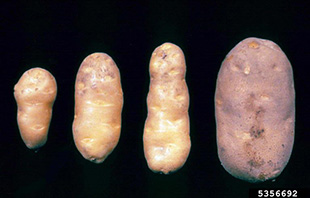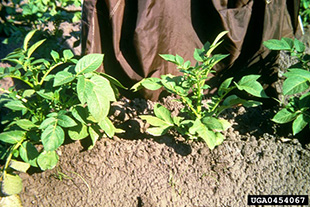
Potato Spindle Tuber Viroid

Potato Spindle Tuber Viroid (PSTVd) is a plant pest which is a serious threat to tomato and potato production in New South Wales. This disease has not been found in NSW potato crops, however during 2011 and 2012 detections of PSTVd occurred in greenhouse grown tomatoes. Infected crops were destroyed.
PSTVd is difficult to diagnose by observation alone as symptoms resemble those caused by nutrient deficiency, root disease or spray drift damage. Suspect infected plants should be diagnosed by an accredited laboratory.
An outbreak of PSTVd in potatoes could lead to production losses of between 10-60% to the NSW potato industry which has a value of around $50 million dollars annually.
Current situation

PSTVd has been detected in tomatoes and capsicums in Western Australia and in tomatoes and ornamentals in Queensland. The disease is being eradicated from tomatoes in South Australia. The disease has been successfully eradicated from commercial vegetable production facilities in Victoria and NSW.
PSTVd has not been reported in Australian potato crops. As part of a collaborative effort to manage the risk of PSTVd in potatoes the NSW, Victorian and South Australian state governments agreed to regulate seed potatoes and other potato propagative material entering each state.
The NSW potato industry and the NSW Seed Potato Protected Areas need protection from this disease. Regulation and disease free status will ensure continued access to domestic and international markets.
Notifiable status
Potato Spindle Tuber Viroid is a notifiable plant disease in NSW.
All notifiable plant pests and diseases must be reported within 1 working day. You can report notifiable plant pests and diseases by one of the following methods:
- Call the Exotic Plant Pest Hotline 1800 084 881
- Email biosecurity@dpi.nsw.gov.au with a clear photo and your contact details
- Complete an online form
A full list of notifiable plant pests and diseases can be found in Schedule 2 of the NSW Biosecurity Act 2015.
New legislation for controlled movement of seed potatoes for planting
Legislation to be adopted in NSW will be in line with Victoria and South Australia and will mitigate the risk of introducing PSTVd into NSW. This will be achieved by controlling the movement of potato propagative material, including seed potatoes, into NSW and the NSW Seed Potato Protected Areas.
Potato propagative material (including seed potatoes) will be restricted entry unless produced under a certification scheme that meets the National Standard for Certification of Seed Potatoes, or has been grown in an area free from PSTVd.
Implications for NSW potato growers
The new legislation will have little impact on seed potato growers in the NSW Seed Potato Protected Areas as the conditions imposed under the PSTVd legislation are similar to those in existing legislation for other exotic pests and diseases.
Growers outside the NSW Seed Potato Protected Areas will need to source all potato propagative material from either a state, or part of a state, with an area freedom certificate in force for PSTVd, or plant only certified seed potatoes.
How can we limit the risk of introducing PSTVd into NSW potato crops?
To minimise the risk of pests and diseases, ensure that all seed potato used for sowing is certified through an accredited program or sourced from an area free of the disease.
For more information on regulation of seed potatoes, contact Bev Zurbo Industry Liaison Officer on 02 6938 1976 or email bev.zurbo@dpi.nsw.gov.au.
PSTVd in tomatoes
PSTVd symptoms can be variable. The severity of symptoms depends on the strain of the viroid (both mild and severe strains exist), the host, the host cultivar and environmental conditions. The disease is difficult to diagnose in tomatoes because mild strains generally cause no obvious symptoms or symptoms can be similar to those caused by nutrient deficiency, root disease or spray drift damage from hormone weedkillers.
Leaf symptoms
In a mature plant, symptoms are usually first seen in the plant head. Leaves become yellowed and have a purplish tinge while the main veins remain bright green. Leaves are smaller than normal, bunched together, often down-curled, distorted and brittle.
Internodes are shortened so that affected shoots appear stunted. In the most severe cases dieback may develop along the veins and the leaves die.
Fruit symptoms and yield
PSTVd is often not obvious in a tomato crop until around 2-3 months after planting, after the fifth flowering truss has developed. Flowers often abort. Infected fruit may appear small, dark green and hard and ripen irregularly. The yield of marketable tomatoes from affected plants can be significantly reduced, but varies with plant age, age when infected and disease severity. Losses of 10-60% have been reported.
Infection and severity
Tomato plants are unlikely to recover from infection with PSTVd because the infection is systemic. If the head is removed the disease can move downwards in the phloem and into the laterals. Temperature affects viroid levels and symptom severity, with greater amounts of viroid in the plant and more severe symptoms at high temperatures (25-37 oC). Some reports indicate that high light intensity increases symptom severity.
Hosts
The principal hosts of PSTVd are tomatoes, potatoes, solanaceous ornamentals and solanaceous weeds. PSTVd is generally symptomless in ornamentals and weeds.
What is a viroid?
Viroids are extremely simple virus-like microorganisms. They are the smallest agents known to cause serious diseases in plants. Like viruses, viroids multiply only in living plant cells. A characteristic feature of viroids is that they can survive in sap and crop debris after the plant has died. Viroid diseases are especially common in solanaceous and asteraceae hosts and in most cases are not host-specific. PSTVd is one of about 30 viroids that have been described, several of which cause diseases in tomato (for example, tomato apical stunt viroid).
Disease spread
Mechanically
PSTVd is highly transmissible and is easily spread from infected to healthy tomato plants. The viroid spreads in tomato sap through natural plant to plant leaf contact, when plants are handled and on greenhouse equipment including knives, support string, clips, trolleys and crates. PSTVd can be transferred in whole fruit but this is more likely when the fruit has been damaged. Local spread occurs down rows in the direction of work and clusters of several affected plants are likely to occur together. Viroid transfer by root contact between plants in the same slab or container is considered unlikely.
In seed
Sporadic outbreaks of PSTVd in greenhouse tomatoes in Australia are believed to have arisen from infected seed. Seed infection is internal and levels of 10% infection have been recorded in tomato seed. Quarantine conditions apply to the importation of tomato seeds into Australia. It is possible that PSTVd also spreads in pollen and that the pollen carried by bees in greenhouse crop pollination could spread infection within the crop.
Vectors
There is a risk that aphids may spread PSTVd. This risk is probably low in commercial greenhouse tomato crops when pest insects are actively managed.
Debris
PSTVd can survive in dried tomato sap for more than eight weeks and in infected leaf debris for over six months. Thorough compositing will kill the viroid.
Actions to minimise risks
The factsheet Keep it Clean: Reducing costs and losses in the management of pests and diseases in the greenhouse (PDF, 5451.08 KB) lists 10 essential practices to implement on your farm.
- Regularly monitor and correctly identify pests and diseases (or have them identified for you) to ensure early detection and correct identification of problems.
- Use action points and check pest and disease information for all your decision making including chemical, biological, whole-crop and hot-spot treatments.
- Quarantine your greenhouse within a ‘clean’ zone separated from the ‘outside’ zone of the farm.
- Use check and control points to manage the movement of people, vehicles, plants and materials into your ‘clean’ zone.
- Make sure employees and visitors do not visit another greenhouse before entering your greenhouse.
- Always thoroughly clean and disinfect your greenhouse and fixtures before planting a new crop.
- Inspect all seedlings to ensure they are free from pests and diseases before they are planted out into a clean greenhouse.
- Maintain a 5-10 metre wide plant free buffer around every greenhouse.
- Keep your greenhouse and farm surrounds weed free. Remove, stockpile and dispose of crop debris outside the ‘clean’ zone and away from the greenhouse.
Although management controls cannot ensure that PSTVd will not become established the risks can be reduced. Examples of successful eradication of PSTVd from tomato greenhouses are linked to timely and strict implementation of a range of measures:
- Grow only a single crop at a time in the greenhouse
- Do not grow any solanaceous ornamentals (eg petunias) in or near the same greenhouse as tomatoes. Be aware that some solanaceous ornamental garden plants can be symptomless hosts for PSTVd
- Wear disposable gloves when in the greenhouse and change them frequently, at least at the top of each new row
- Perform all plant handling tasks in the same direction along a row
- Regularly disinfect pruning tools and equipment
- Replace or disinfect support strings and clips between crops
- Avoid excessive temperatures in the greenhouse
- Control volunteer tomato seedlings and solanaceous weeds (eg nightshade) in and around tomato greenhouses

